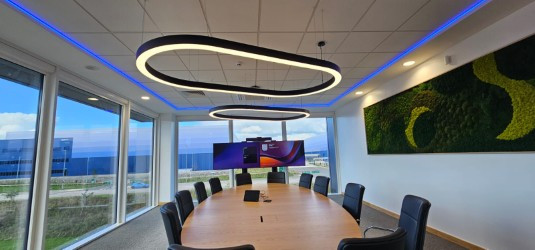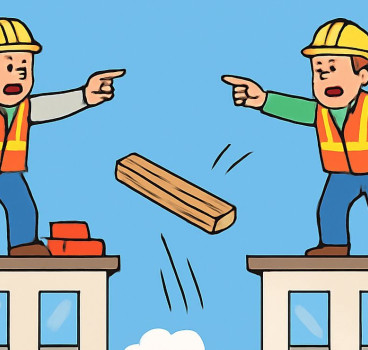The rise of mass timber for tall buildings
A revolution is brewing in the construction industry and it's made of wood. To be more precise, we are talking here about mass or laminated timbers, game-changers that are transforming the way we build tall and sustainable structures, writes John Ridgeway.
Timber, of course, has been a key component within the construction industry for centuries unlike mass timber, a family of engineered wood products manufactured by bonding smaller wood elements such as laminations, veneers or solid wood together with adhesives or mechanical fasteners. This creates robust, high-performance building components with exceptional strength and fire resistance and is a relatively recent development.
As a result, the global mass timber market is experiencing explosive growth, driven by a wide range of different factors. Estimates suggest that the market size reached around USD 1 billion in 2023. Experts anticipate continued strong growth, with projections suggesting the market will reach a staggering USD2 to 3.3 billion by 2033, reflecting a robust compound annual growth rate (CAGR) of 8% to 14.7%.
Several factors are propelling the mass timber market forward, such as rising demand for sustainable construction. Sustainability concerns are increasingly driving construction practices and mass timber, with its lower carbon footprint compared to traditional materials, aligns perfectly with this trend.
The rapid urbanisation of cities worldwide also necessitates innovative and sustainable construction solutions and mass timber offers a promising alternative for high-rise and multi-unit buildings. This, together with continuous advancements in mass timber technology are leading to the development of even stronger, more fire-resistant and more versatile products.
The next five years
The next five years are expected to witness significant advancements in the mass timber industry. According to industry experts we can expect to see a wider variety of mass timber products emerge, catering to diverse construction needs and applications. As production processes become more efficient and economies of scale come into play, mass timber is also expected to become more cost-competitive with traditional materials.
The use of mass timber is currently concentrated in the developed world - however, it is expected to gain traction in new markets across the globe in the coming years.
Research and development efforts will also continue to focus on improving the fire resistance of mass timber products, addressing potential concerns and paving the way for wider building code acceptance. Furthermore, mass timber construction is likely to be increasingly integrated with other technologies like digital design and fabrication, further enhancing efficiency and cost-effectiveness.
What is Mass Timber?
Mass timber is not a single product, but rather a category encompassing various types. They include Glulam (Glued Laminated Timber), which are predominantly long, straight beams formed by gluing layers of timber with the grain running parallel and are popular for beams, columns and arches.
CLT (Cross-Laminated Timber), another major category, are panels made by layering solid wood boards with perpendicular grain orientation. These are known for superior strength and dimensional stability, making them ideal for walls, floors and roofs.
NLT (Nail Laminated Timber), is similar to glulam but uses nails instead of adhesives for faster and more cost-effective production and is suitable for beams and columns.
Finally, LVL (Laminated Veneer Lumber), which is composed of thin wood veneers bonded together with the grain running parallel, also offers high strength-to-weight ratio and is often used for beams and headers.
As already discussed, the use of mass timber is rapidly expanding globally and has been used on many high profile and high rise buildings such as the T3 (Vancouver, Canada), an 18-story residential tower, one of the tallest mass timber buildings in the world.
Brock Commons Tallwood House (also in Vancouver, Canada), is a student dormitory built with CLT panels, demonstrating the use of mass timber in educational facilities. The Cube (Amsterdam, Netherlands), is a mixed-use office building featuring a CLT core and exposed timber beams, highlighting the aesthetic appeal of mass timber and the Suma building (Bergen, Norway), a 14-story high-rise apartment building utilising CLT panels, emphasises the fire resistance properties of mass timber.
These are just a few examples, and the list is constantly growing. As awareness and acceptance of mass timber increase, we can expect to see it utilised in a wider range of building types, from commercial structures and schools to hospitals and public spaces.
Why is mass timber different?
Mass timber offers several advantages that set it apart from traditional construction materials. Engineered wood products deliver impressive strength-to-weight ratios, making them suitable for large-scale building projects. Additionally, proper treatment can enhance durability and resistance to rot and insects.
Wood is a renewable resource, and sustainably managed forests can provide a continuous supply for mass timber production. Additionally, timber construction offers a lower carbon footprint compared to concrete and steel. Contrary to popular belief, mass timber can also perform surprisingly well in fires. The large cross-sections of mass timber elements act as a natural insulator, delaying the charring process and maintaining structural integrity for longer periods.
For designers, exposed mass timber elements offer a warm and natural aesthetic, often favoured by architects. This can create a unique and inviting atmosphere within buildings. Prefabricated mass timber components can also be quickly assembled on-site, leading to faster construction times compared to traditional methods. Furthermore, studies suggest that wood-based buildings can provide improved indoor air quality by regulating humidity and reducing the presence of harmful chemicals.
A History Rooted in Innovation:
The concept of using engineered wood products for construction dates back several centuries. Half-timber framing, where wood posts and beams are infilled with brick or masonry, is a historical example. However, the development of modern mass timber products with advanced adhesives and manufacturing processes is a relatively recent phenomenon, as already mentioned.
That said, the rise of mass timber presents a significant opportunity to transform the construction industry towards a more sustainable future. By using wood, a renewable resource, mass timber construction has a lower embodied carbon footprint compared to concrete and steel-based structures. The production of mass timber also requires less energy compared to steel and concrete.
Additionally, the good thermal insulation properties of wood can contribute to lower energy consumption for heating and cooling buildings and because mass timber construction often utilises offcuts and smaller wood elements during production, waste is minimised compared to traditional methods.
Challenges
But, while the future of mass timber appears bright, some challenges need to be addressed. Building codes and regulations in some regions may not yet fully accommodate the use of mass timber in taller buildings. Advocacy efforts are underway to update these codes and standards to reflect the advancements in the technology.
Depending on the local building code and project specifications, additional fireproofing measures might also be required for mass timber elements. This can add some cost to the construction process.
In spite of this, the potential of mass timber is undeniable. With its combination of strength, sustainability and aesthetic appeal, it offers a viable alternative to traditional construction materials and as research and development continue, we can expect to see even more innovative mass timber products and construction techniques emerge.
These include hybrid construction, where mass timber is integrated with other materials like steel and concrete to optimise structural performance and aesthetics. Advanced digital tools can also streamline the design and fabrication of complex mass timber structures, leading to increased efficiency and cost-effectiveness.
Mass timber represents a significant step towards a more sustainable and innovative future for construction. By embracing this revolutionary material, we can build taller, stronger and more environmentally conscious structures that enhance our cities and improve our lives – and we will there to document it.
Additional Blogs

The changing face of workplace AV and what FM managers need to know
In today’s hybrid workplaces, facilities managers can no longer treat audio-visual systems as background infrastructure - they are now mission-critical assets that directly influence productivity,...
Read moreConstruction’s obsession with blame instead of learning
Construction is one of the most technically advanced industries in the built environment, yet culturally it often behaves like one of the least reflective. When things go wrong and they frequently...
Read more

How risk Is routinely pushed down the supply chain
Risk is an unavoidable part of construction. Every project involves uncertainty around ground conditions, weather, design coordination, procurement, labour and programme. Yet while risk is inherent,...
Read more